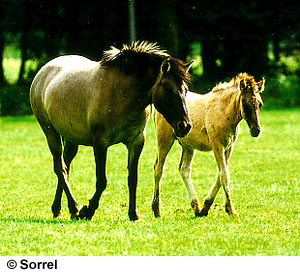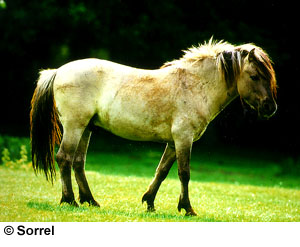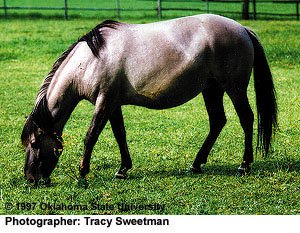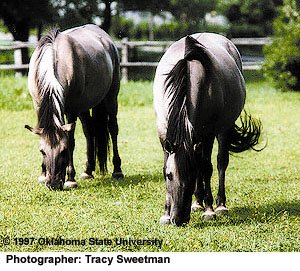Tarpan Horses
The Tarpan is a prehistoric wild horse type.
Where did they live?
The Tarpan ranged from Southern France and Spain eastward to central Russia. Cave drawings of Tarpan horses can be found in France and Spain, and artifacts showing this breed can be found in Southern Russia where this horse was domesticated by Scythian nomads in about 3000 B.C.
Is the Tarpan horse extinct?
The original wild Tarpan died out during the late 1800's. The last Tarpan horse died an a Ukranian game preserve at Askania Nova in 1876.
Why did they die out?
When their natural forest and steppe habitat was destroyed to make room for more people, they came into conflict with farmers who did not want the wild Tarpans eating their crops or stealing their tame mares.
The farmers in Eastern Europe treated the Tarpan in much the same manner as mustangs and wild burros are treated in the United States today.
Did anyone try to save the Tarpan?
The Polish government created a preserve for animals descended from the wild Tarpan at a forest in Bialowieza. Over the years this herd has developed more and more Tarpan characteristics. Today this breed is sometimes referred to as the Polish Primitive Horse.
If the Tarpan is extinct, how can it exist today?
The modern Tarpan is a genetic recreation of the original wild breed.
Who recreated the Tarpan?
Heinz and Lutz Heck, two German zoologists working at the Tierpark Hellabrunn (Munich Zoo) in Germany.
How?
They believed that all living creatures were the result of their genetic make-up and that genes could be rearranged like the pieces of a puzzle to recreate certain vanished species. Only breeds that still had living descendants could be recreated because those living breeds would be a source for genetic material.
What breeds were used to recreate the Tarpan?
Several European pony breeds had descended from the prehistoric Tarpan. Primarily the Heck Brothers selected Polish Koniks, Icelandic Ponies, Swedish Gotlands and Polish Primitive Horses from the preserve in Bialowieza.
Mares from these breeds were then mated to Przewalski stallions because the Heck brothers felt that the blood of the wild Przewalski would
serve as a catalyst to draw out the latent Tarpan characteristics dormant in these
more modern breeds.
When was the Tarpan bred back?
The first bred back Tarpan, a colt, was born May 22, 1933 at the Tierpark Hellabrunn in Munich, Germany.
What does a Tarpan look like?
The Tarpan is mouse dun or grulla in color. This means that the body is a smoky gray color, with the face and legs being darker than the body. The mane and tail are flaxen, but dark in the center where the dorsal stripe passes through. They stand between 13 and 13.2 hands tall. The mane is semi-erect. The head is large, with massive jaws and thick neck. The back is short and strong, with very low withers. The hooves are dark and very tough, never requiring shoes.
What kind of temperament do they have?
The Tarpan has a very calm disposition. They are friendly, curious and affectionate. The Tarpan is extremely intelligent. They are independent and quite stubborn. The Tarpan, unlike the domesticated modern horse, has not surrendered its freedom to man in trade for food and care, and therefore tends to rely more on its own view of a situation rather than to allow its owner to make decisions for it.
Can they be ridden?
Yes, they seem to enjoy being ridden, but they do not like being told where to go. They do eventually respond to direction from the rider if patience is used. If the rider resorts to force rather than love, then the Tarpan may refuse to cooperate.
Tarpan horses have a natural ability to jump and also seem to enjoy pulling a cart.
How many Tarpan horses are there?
There are about 50 Tarpans in North America, and perhaps only 100 in the world.
When was the first Tarpan imported into the United States?
In 1954 a stallion named Duke was imported by the Chicago Zoological Park in Illinois. In 1955 two mares were acquired by the Chicago Zoo. In 1962 the Ft. Worth Zoological Park in Texas imported a Tarpan mare. All of the Tarpans now in North America trace back to these six animal from Tierpark Hellabrunn in Germany.
Are most Tarpans in zoos?
Most of the Tarpans now in the United States are owned by private individuals.
What do the Tarpan owners do with their animals?
Most Tarpan owners are breeders who are trying to increase the population of this rare breed. A few are developing their Tarpans for riding.
The Tarpan has the potential to excel in the field of endurance competition, in fact, several owners are now participating in N.A.T.R.C. sponsored Competitive Trail Rides on their little horses, and have found that Tarpans can successfully compete against larger breeds. They are extremely agile, and cover long distances without requiring horse shoes.
Their calm disposition makes them excellent mounts for children. They are also presently being used in riding programs for physically and mentally handicapped riders.
Tarpan horses enjoy working with cattle and other livestock.
What about their small size?
The sturdy conformation and strong legs of the Tarpan enable them to carry a large adult rider with ease. Riders who prefer a larger mount can cross the Tarpan with other breeds to obtain an animal with some Tarpan characteristics.
What breeds are usually crossed with Tarpans?
The most popular is to a Welsh-Arab. In fact, a new breed called the Canadian Rustic Pony was developed by Dr. Peter Neifeld of Manitoba, Canada using a combination of these three breeds. In Europe, Tarpans are being bred to Thoroughbred mares to produce hunters.
Additional information available from the North American Tarpan Association, Director: Lynda Konrad Box 35 Hythe, Alberta Canada T0H 2C0
Phone: (780) 356-2747
Fax: (780) 354-8440
Email: tarpan@pwsb33.ab.ca
References
Kentucky Horse Park, 4089 Iron Works Pike, Lexington, KY 40511
Tarpan Horse GalleryTake a closer look at the Tarpan horse breed.










